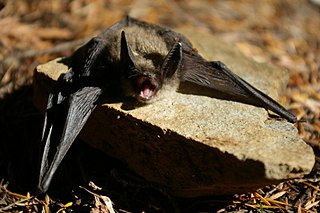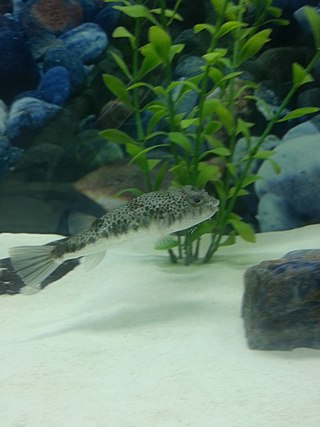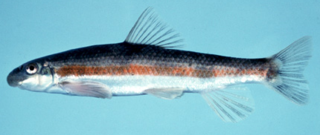
The International Union for Conservation of Nature (IUCN) is an international organization working in the field of nature conservation and sustainable use of natural resources. Founded in 1948, IUCN has become the global authority on the status of the natural world and the measures needed to safeguard it. It is involved in data gathering and analysis, research, field projects, advocacy, and education. IUCN's mission is to "influence, encourage and assist societies throughout the world to conserve nature and to ensure that any use of natural resources is equitable and ecologically sustainable".

The International Union for Conservation of Nature (IUCN) Red List of Threatened Species, also known as the IUCN Red List or Red Data Book, founded in 1964, is an inventory of the global conservation status and extinction risk of biological species. A series of Regional Red Lists, which assess the risk of extinction to species within a political management unit, are also produced by countries and organizations.

The brown skua, also known as the Antarctic skua, subantarctic skua, southern great skua, southern skua, or hākoakoa (Māori), is a large seabird that breeds in the subantarctic and Antarctic zones and moves further north when not breeding. Its taxonomy is highly complex and a matter of dispute, with some splitting it into two or three species: Falkland skua, Tristan skua, and subantarctic skua. To further confuse, it hybridizes with both the south polar and Chilean skuas, and the entire group has been considered to be a subspecies of the great skua, a species otherwise restricted to the Northern Hemisphere.
The conservation status of a group of organisms indicates whether the group still exists and how likely the group is to become extinct in the near future. Many factors are taken into account when assessing conservation status: not simply the number of individuals remaining, but the overall increase or decrease in the population over time, breeding success rates, and known threats. Various systems of conservation status are in use at international, multi-country, national and local levels, as well as for consumer use such as sustainable seafood advisory lists and certification. The two international systems are by the International Union for Conservation of Nature (IUCN) and The Convention on International Trade in Endangered Species of Wild Fauna and Flora (CITES).

NatureServe, Inc. is a non-profit organization based in Arlington County, Virginia, US, that provides proprietary wildlife conservation-related data, tools, and services to private and government clients, partner organizations, and the public. NatureServe reports being "headquartered in Arlington, Virginia, with regional offices in four U.S. locations and in Canada." In calendar year 2011 they reported having 86 employees, 6 volunteers, and 15 independent officers.

The black pond turtle, also known commonly as the spotted pond turtle and the Indian spotted turtle, is a species of freshwater turtle in the family Geoemydidae. The species, which is endemic to South Asia, belongs to the monotypic genus Geoclemys.

The kalij pheasant, or simply kalij, is a pheasant found in forests and thickets, especially in the Himalayan foothills, from Nepal, Pakistan to western Thailand. Males are rather variable depending on the subspecies involved, but all have at least partially glossy bluish-black plumage, while females are overall brownish. Both sexes have a bare red face and greyish legs. It is generally common and widespread, though three of its eastern subspecies are considered threatened and L. l. moffitti is virtually unknown in the wild. On 21 October 2021, the Government of Jammu and Kashmir declared Kalij Pheasant as bird of the Union Territory of Jammu and Kashmir.

The Hamilton's frog is a primitive frog native to New Zealand, one of only three extant species belonging to the family Leiopelmatidae. New Zealand's frog species all are in the family Leiopelmatidae. The male remains with the eggs to protect them and allows the tadpoles to climb onto his back where they are kept moist. It is named in honour of Harold Hamilton the collector of the type specimen. The holotype is in the collection of the Museum of New Zealand Te Papa Tongarewa.

The Maud Island frog has been recently been synonymised with Hamilton's frog

Megalocranchia fisheri is a species of glass squid. Its natural range covers at least the waters off Hawaii. The species may attain a mantle length of 1.8 m (5.9 ft) and a total length of over 2.7 m (8.9 ft), making it one of the largest species of squid, together with the colossal squid, the giant squid, and the robust clubhook squid. It inhabits surface and mid-depth waters of open ocean. Juveniles live near the surface, while adults occupy mesopelagic depths during the day and migrate to near-surface waters at night. M. fisheri possesses two large light organs in the gill cavity. Females additionally have light organs on the ends of their third arm pair. As the animal matures, its fins become spear-like in appearance.
A data deficient (DD) species is one which has been categorized by the International Union for Conservation of Nature (IUCN) as offering insufficient information for a proper assessment of conservation status to be made. This does not necessarily indicate that the species has not been extensively studied, but it usually indicates that little or no information is available on the abundance and distribution of the species. It can also indicate uncertainty about the taxonomic classification of an organism; for example, the IUCN classifies the orca as "data deficient" because of the likelihood that two or more types of the whale are separate species.

Keen's myotis is a species of vesper bat. It is found in British Columbia in Canada and in Washington and Alaska in the United States. It is named after the Rev. John Henry Keen, who collected the specimen that formed the basis for the first scientific description of the species. Classification for Keen's myotis formerly included the northern long-eared myotis, resulting in older studies confusing the species for one another.
The Florida mouse is a species of rodent in the Cricetidae family. It is the only species in the genus Podomys. True to its name, it is endemic to Florida in the United States.
The blackfin sucker is a species of ray-finned fish in the family Catostomidae. It is found only in the United States in the headwaters of the Barren River system in south central Kentucky and Tennessee.

Hamilton's tomb bat is a species of sac-winged bat in the family Emballonuridae. It is found in Chad, Kenya, Somalia, South Sudan, Tanzania, and Uganda. Its natural habitat is savanna.

The colossal squid is the world’s largest squid species and the world’s largest mollusc. It belongs to the Cranchiidae family, that of the cockatoo squids or glass squids. It is sometimes called the Antarctic cranch squid or giant squid and is believed to be the largest squid species in terms of mass. It is the only recognized member of the genus Mesonychoteuthis and is known from only a small number of specimens. The species is confirmed to reach a mass of at least 495 kilograms (1,091 lb), though the largest specimens—known only from beaks found in sperm whale stomachs—may perhaps weigh as much as 600–700 kilograms (1,300–1,500 lb), making it the largest known invertebrate. Maximum total length has been estimated between 10 metres (33 ft) and 14 metres (46 ft) but the former estimate is more likely. The colossal squid has the largest eyes of any known creature ever to exist, with an estimated diameter of 27–30 cm (11–12 in) to 40 cm (16 in) for the largest collected specimen.

The common toadfish, also known as the common toado, toadfish or toado, is a species of fish in the family Tetraodontidae of order Tetraodontiformes, found along Australia's eastern coast, from northern Queensland to Flinders Island, and around Lord Howe Island, as well as in New Zealand waters. It often buries itself in sand with only its eyes exposed.

Thoburnia is a genus of suckers found in the eastern United States. There are currently three recognized species in this genus. Formerly regarded as a subgenus of the genus Moxostoma before elevation to full genus.

Thoburnia rhothoeca is a species of fish native to Virginia and West Virginia.
















